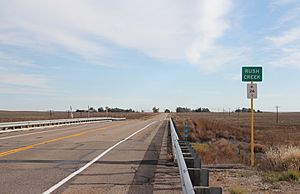Rush Creek (Colorado) facts for kids
Quick facts for kids Rush Creek |
|
|---|---|
| Physical characteristics | |
| Main source | Confluence of North Rush Creek and South Rush Creek 38°48′06″N 103°27′02″W / 38.80167°N 103.45056°W |
| River mouth | Confluence with Big Sandy Creek 3,796 ft (1,157 m) 38°22′02″N 102°31′39″W / 38.36722°N 102.52750°W |
| Basin features | |
| Progression | Big Sandy Creek— Arkansas—Mississippi |
| Basin size | 1,378 sq mi (3,570 km2) |
Rush Creek is a 102-mile-long (164 km) stream in Colorado. It's like a smaller river that flows into a bigger one. This type of stream is called a tributary. Rush Creek is a tributary of Big Sandy Creek.
Rush Creek starts in Lincoln County. It begins where two smaller streams, South Rush Creek and North Rush Creek, meet. The creek then travels through Cheyenne County. Finally, it joins Big Sandy Creek in Kiowa County.
Contents
The Journey of Rush Creek
Rush Creek's journey begins in eastern Colorado. It flows through flat plains and open lands. The creek helps carry water across this dry region. It collects water from a large area, about 1,378 sq mi (3,570 km2). This area is called its drainage basin.
From Small Streams to Big Rivers
Rush Creek starts as two smaller streams. These streams join together to form the main creek. As it flows, Rush Creek picks up more water. It eventually meets Big Sandy Creek. Big Sandy Creek is also a tributary. It flows into the Arkansas River.
Connecting to the Mississippi
The Arkansas River is a very long river. It flows across several states. The Arkansas River then joins the mighty Mississippi River. This means that water from Rush Creek can eventually reach the Mississippi River. From there, it flows all the way to the Gulf of Mexico. It's like a long water highway!
Why Rivers Like Rush Creek Matter
Rivers and creeks are super important for many reasons. They provide water for plants and animals. They also help shape the land around them.
Home for Wildlife
Even in dry areas, creeks like Rush Creek are vital. They create green spaces where animals can find water. Many types of birds, small mammals, and insects depend on these waterways. They use the creek for drinking, finding food, and shelter.
Water for People
People also rely on rivers and creeks. They provide water for farms and towns. While Rush Creek is not a major water source for large cities, it contributes to the overall water system. This system supports life in eastern Colorado.
Shaping the Landscape
Over thousands of years, rivers carve out valleys. They also move soil and rocks. This process is called erosion. Rush Creek helps shape the landscape of the plains. It creates the path it flows through.
Fun Facts About Rivers
- The longest river in the world is the Nile River. It is about 4,132 miles (6,650 km) long.
- Rivers are always flowing downhill. They are pulled by gravity.
- A river's mouth is where it ends. This is usually where it flows into another river, a lake, or the ocean.
- The area where a river starts is called its source. For Rush Creek, its source is where North and South Rush Creek meet.


